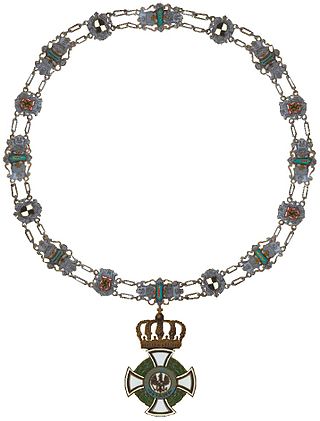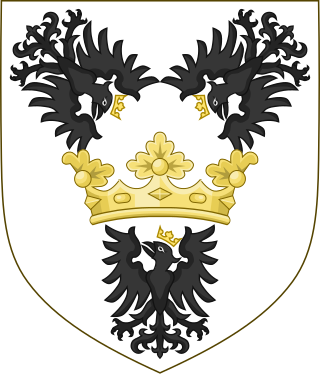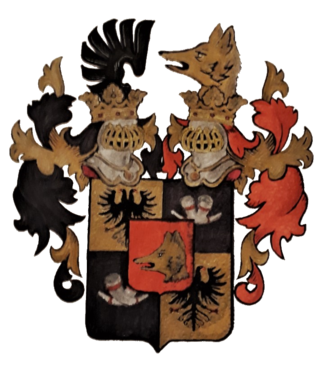This article needs additional citations for verification .(March 2011) |
Von Schmidt auf Altenstadt is a Dutch and former German noble family. Also known as Schmidt von Altenstadt, it has branches in other countries including the Netherlands.
This article needs additional citations for verification .(March 2011) |
Von Schmidt auf Altenstadt is a Dutch and former German noble family. Also known as Schmidt von Altenstadt, it has branches in other countries including the Netherlands.
Johann Fabricius served Maximilian II against the Turks and was given a coat of arms by the imperial Letters Patent of 2 November 1564. [1] His son Martin was ennobled on 10 December 1577. They were granted a swan coat-of-arms where the swan is in an attack position on the shield; this is repeated in miniature "above the crown". [2]
The Fabricius family reverted around 1638 to the surname of Schmidt and on 23 February 1713, were granted the additive "auf Altenstadt".
On 18 October 1712/23 February 1713 the Emperor Charles VI granted augmentation of a knight's arm holding a sword to the swan coat-of-arms, to heirs Anton Johann Christoph, Johann Georg, and Christopher Wolf (successive lords of Gattendorf).[ clarification needed ] The three brothers succeeded each other, one after the other, as lords of Gattendorf; the first two died without heirs. The third brother had children and the line continued.
Family members are still to be found in the Netherlands, the United States and England.
A direct descendant from Johann Schmidt/Fabricius was Hans-Georg who grew up in Danzig, West Prussia. Hans-Georg Schmidt von Altenstadt (21 August 1904 − 25 July 1944) was Generalmajor of the Wehrmacht on 1 July 1944. [4] He was married to the former Lillian Thordsen with whom he had three daughters. His father, Ulrich Friedrich Philipp, (born 1872) was a major and adjutant to Field-marshal von Mackensen, Commander of life Hussar Brigade in Danzig-Langfur. His grandfather Eduard von Altenstadt married in Gross-Medunischken with Anna Theodora von Bujack (1848-1910) married on 28 June 1868 and his elder son Sigismund was born in 1869 and his younger son Ulrich (Hans-Georg's father) was born in 1872. Grandfather Eduard was a Major General whose full name was Johann Georg Eduard Schmidt von Altenstadt (1796-1850) who married Johanna Friedericke Auguste Ernestin née Homann (1797-1864).
Hans-Georg Schmidt von Altenstadt was the author of the book Unser Weg zur Meer. [5]

The House of Fugger is a German family that was historically a prominent group of European bankers, members of the fifteenth- and sixteenth-century mercantile patriciate of Augsburg, international mercantile bankers, and venture capitalists. Alongside the Welser family, the Fugger family controlled much of the European economy in the sixteenth century and accumulated enormous wealth. The Fuggers held a near monopoly on the European copper market.

Hof is a town on the banks of the Saale in the northeastern corner of the German state of Bavaria, in the Franconian region, at the Czech border and the forested Fichtelgebirge and Frankenwald upland regions. The town has 47,296 inhabitants, the surrounding district an additional 95,000.

Ringen is the German language term for grappling (wrestling). In the context of the German school of historical European martial arts during the Late Middle Ages and the German Renaissance, Ringen refers to unarmed combat in general, including grappling techniques used as part of swordsmanship.

The House Order of Hohenzollern was a dynastic order of knighthood of the House of Hohenzollern awarded to military commissioned officers and civilians of comparable status. Associated with the various versions of the order were crosses and medals which could be awarded to lower-ranking soldiers and civilians.

Gattendorf is a municipality in Upper Franconia in the district of Hof in Bavaria, Germany.

The House of Eggenberg was the name of an influential Austrian noble family from Styria, who achieved princely rank in the 17th century. The family's last male heir died in 1717, bringing an end to the House of Eggenberg.

The House of Franckenstein is the name of a feudal, Franconian noble family in Germany, descendants from the Dynasts of the Breuberg family; offsprings of the Lords of Lützelbach from Höchst im Odenwald.

Ulrich II von Graben was a Styrian noble, a member of the edelfrei Von Graben family. He held the titles as Lord of Kornberg and Graben Castle, as well as burgrave of Gleichenberg, Rothenfels and Hohenwang.
Ulrich of Hardegg was an Austrian nobleman from the Prüschenk family of Count of Hardegg. He was "Cup-bearer" of Austria, which, by this time, was a title of nobility and no longer involved looking after the arch-duke's wine cellar. He was also steward in Styria.
The House von und zu Manndorff zu Pfannhofen und Wissenau is the name of an ancient Austrian noble family, more specifically the Uradel. They are among the oldest Carinthian noble families still in existence today.

Schlieffen is the name of an old German noble family from Pomerania. The family, branches of which still exist today, originates in Kolberg.

The House of Fenrich was an Austrian lower nobility family of German origin, a branch of the House of Fenner. The family flourished in the late 18th century in Meseritz in South Prussia and moved to Austria-Hungary in the 19th century.

In der Maur is a Swiss family. Throughout the Middle Ages and Renaissance, members of the family held political offices in Berneck, St. Gallen. The In der Maur von Berneck family were first granted a coat of arms in 1478, when Hermann In der Maur was appointed as the Ammann of Berneck of the Abbot of St. Gallen. Members of the family also served as Imperial tax collectors and as clerks of the Court of Berneck. The first member of the family to hold the position of Ammann in Berneck was Ulrich In der Maur in 1435.

The House of Kotzebue was a Baltic German noble family of Brandenburgish origin, tracing its origin back to Kossebau in Altmark. They held nobility status in the Russian Empire and the Kingdom of Bavaria. The English name of the Alaskan Inuit city of Kotzebue, as well as the neighboring Kotzebue Sound, in the Alaskan Arctic take their names from Otto von Kotzebue, a Russian naval officer of this family.

Bekenntnis der Professoren an den Universitäten und Hochschulen zu Adolf Hitler und dem nationalsozialistischen Staat officially translated into English as the Vow of allegiance of the Professors of the German Universities and High-Schools to Adolf Hitler and the National Socialistic State was a document presented on 11 November 1933 at the Albert Hall in Leipzig. It had statements in German, English, Italian, and Spanish by selected German academics and included an appendix of signatories. The purge to remove academics and civil servants with Jewish ancestry began with a law being passed on 7 April 1933. This document was signed by those that remained in support of Nazi Germany.
The German foreign office had a sizable network of diplomatic missions when Nazis came to power in 1933. While it was a deeply traditional and elitist organisation within the German civil service, it enthusiastically helped the Nazis prosecute an ambitious foreign policy.

The House of Poschinger is an ancient Bavarian noble family. Its origin date back to the year 1140. The family received the rank of Knights of the Holy Roman Empire. The Frauenau branch rose to the rank of Barons (Freiherr) in the Kingdom of Bavaria and held a hereditary seat in the House of Councillors.

The Schwarzwald family was a wealthy, patrician, merchant family living in the Hanseatic city of Danzig (Gdańsk) from the 15th to the 18th century. The family, which had its origins in the Black Forest in south-west Germany, can be traced back to Georg von Schwarzwald, who settled in Danzig in the early 1400s.

Portrait Miniature of Hans Schwarzwaldt is a watercolour on vellum portrait completed in around 1535–1540 by German artist and printmaker Hans Holbein the Younger. The painting shows a young man against a clear blue background. Only the head and shoulders are shown, turned three-quarters to the viewer's right, the eyes cast down. The light brown hair is close cropped, and the sitter is wearing a brown doublet, trimmed with black, with a small, open falling collar with white strings attached. There is no inscription. The subject of this portrait was identified as a Danzig merchant, Hans Schwarzwaldt (1513-1575), based on a very strong resemblance to another portrait made by Holbein in 1543, but his age does not match the inscription. It has been suggested that the young man might be Gregory Cromwell, 1st Baron Cromwell, the son of Henry VIII's chief minister, Thomas Cromwell, 1st Earl of Essex.